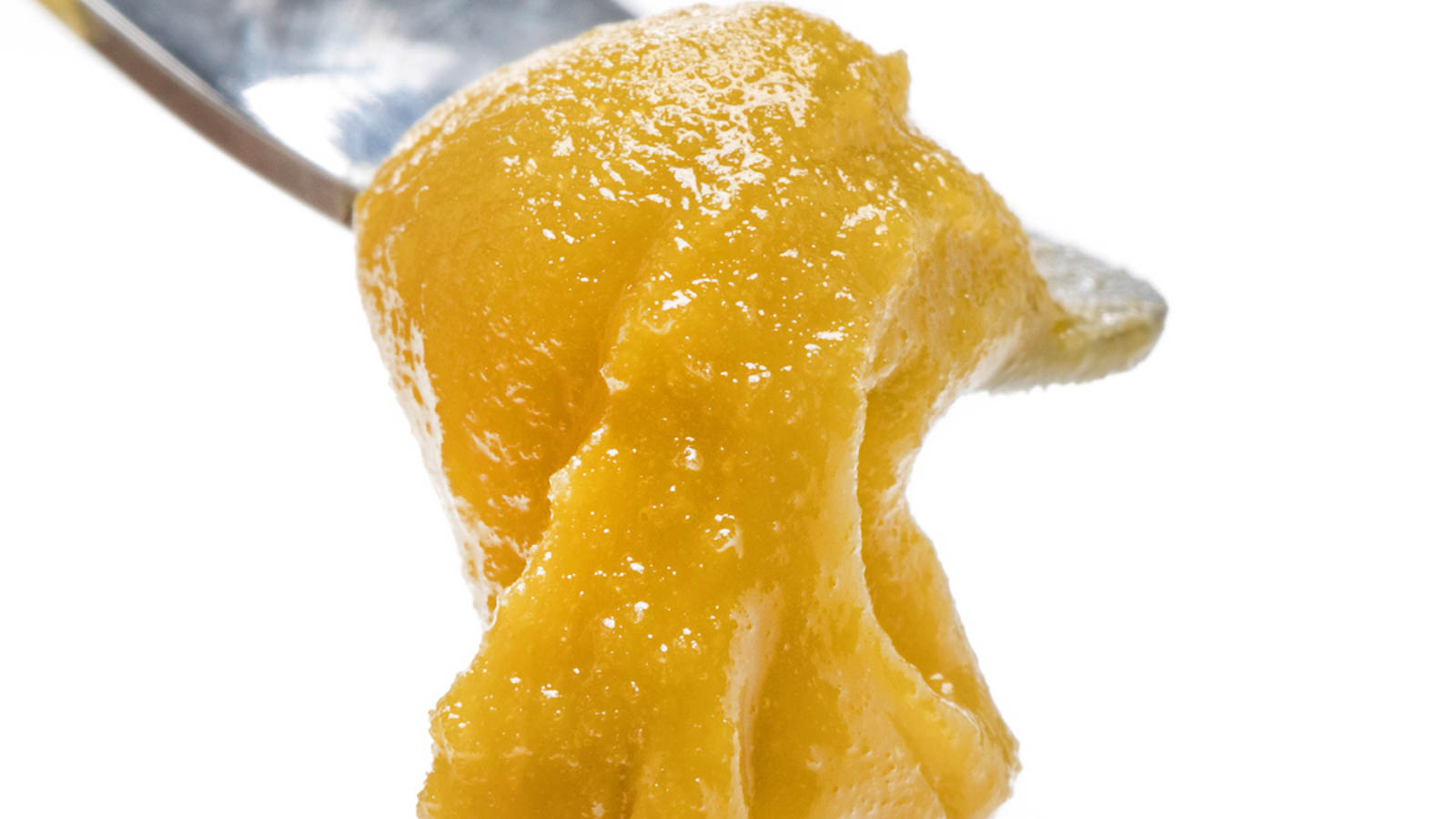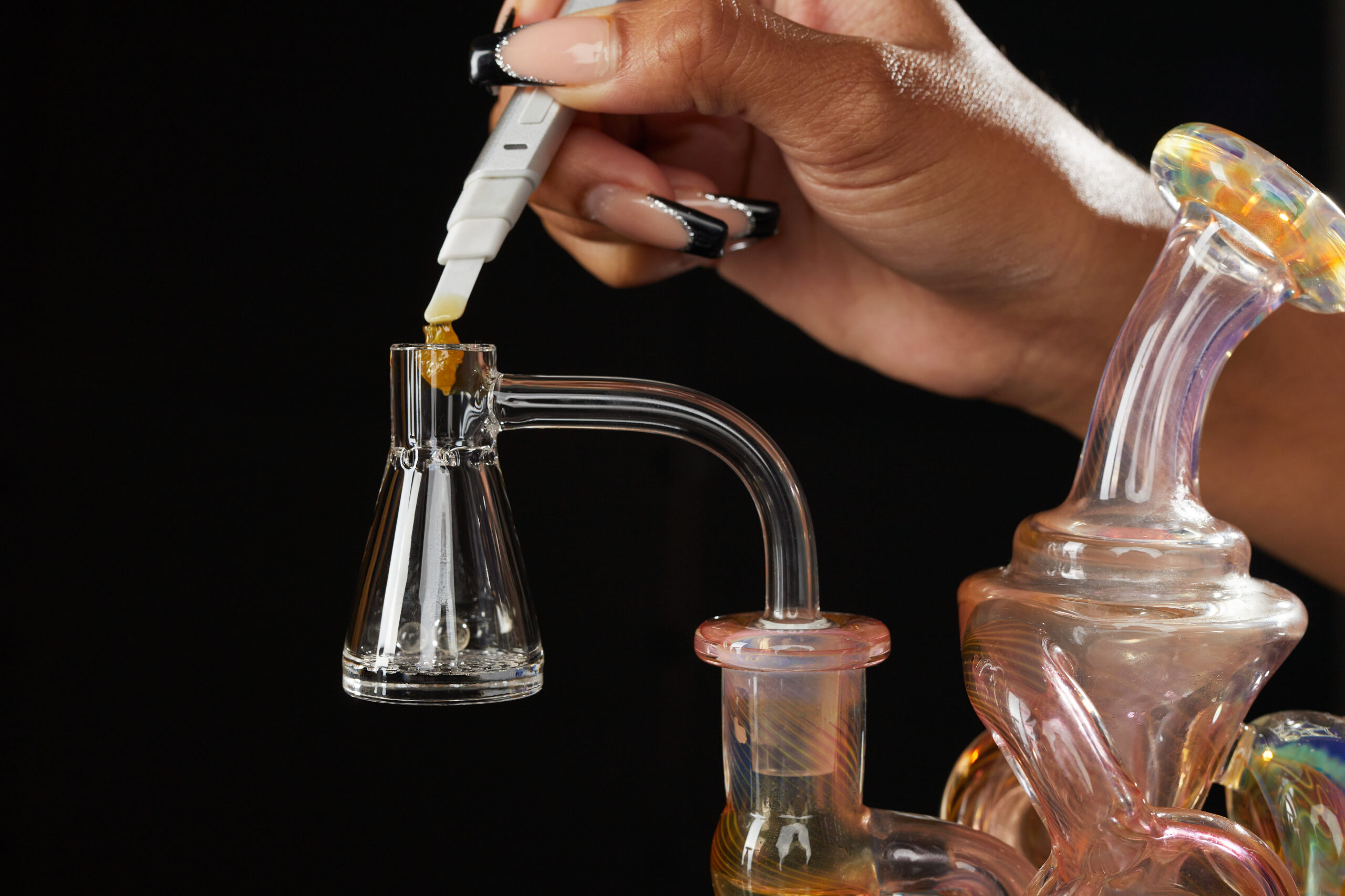Badder, batter, and budder are three names for a family of soft, whipped concentrates that have become staples in both solventless and solvent-based extraction. They are creamy, easy to work with, and capable of expressing a significant amount of terpenes when made with care. Although the names sound different, the textures live in the same neighborhood, and the real distinction comes down to the method used to create them.
What's the difference between badder, batter, and budder?

Photo by Gina Coleman/Weedmaps
Image lightbox

These three names describe slight variations of a soft, aerated texture. Budder is usually the smoothest and most uniform. Batter often appears thicker and glossier. Badder sits comfortably between them, maintaining a creamy body with a touch of texture.
All three should have a blonde to golden color. When the material is handled well, these textures show a bright color, a glossy surface, and a strong aroma.
How these textures are made
There are two very different paths to making badder, batter, and budder. One is entirely solventless and relies on mechanical and temperature factors. The other method uses hydrocarbons and must be performed by licensed professionals in a controlled laboratory environment.
Color and quality
Regardless of the extraction method, high-quality badder, batter, and budder should never appear green. Green indicates that plant material has been incorporated into the final product.
Good concentrates show blond or golden tones, a smooth or glossy surface, and a noticeable aroma. Oxidation and poor handling can cause the product to darken or appear chalky, which typically indicates terpene loss.
Solventless rosin production
In the solventless world, everything begins with trichomes. Fresh frozen material is washed in ice water to separate the heads from the plant. That hash is collected, dried, and pressed into rosin using gentle heat and pressure. When rosin is cold-cured in sealed jars, it naturally begins to change. Light agitation transforms it into a whipped, creamy texture that becomes rosin badder.
This method is clean, safe, and does not require a specialized laboratory environment, as it does not involve any flammable solvents. The texture depends on the natural terpene content of the strain, the curing temperature, and the extent to which the rosin is stirred.
Rosin badder
Rosin has become the backbone of the modern solventless market. Rosin badder is the whipped, creamy texture that forms when rosin is cold-cured and agitated just enough to bring air into the structure. Producers begin with fresh-frozen plant material or high-quality cured inputs, wash them in ice water to collect trichomes, and press the resulting hash into rosin. That rosin rests in sealed jars, where temperature and time transform it into a smooth, rich badder.
A clean rosin badder should never be green. It should range from pale blonde to deep gold and carry a strong, fresh aroma. Because the process preserves the full terpene profile, rosin badder has become a go-to choice for hash holes, infused rolls, and anyone looking for a clean and expressive concentrate.
Solvent-based production
Solvent-based badders, batters, and budders begin with hydrocarbon extraction. Processors use butane or propane in a closed-loop system to pull cannabinoids and terpenes from the plant. Once the extract is collected, it is purged to remove residual solvent and whipped at low heat to create that signature creamy finish.
Because these solvents are volatile, this process must only be performed by licensed professionals in facilities designed for hydrocarbon extraction. For consumers, the safest option is to purchase from tested and regulated dispensaries.
How badder compares to crumble, jam, and sauce
Badder, crumble, jam, and sauce all begin with the same extract. Their differences emerge during curing and finishing.
Badder is soft, creamy, and easy to load. It holds flavor well without being runny.
Crumble is drier and more breakable. It forms a honeycomb-like structure after extended purging.
Jam is composed of small THCA crystals suspended in a thick, syrupy terpene mixture. It has a rich aroma and a glossy look.
Sauce contains large THCA crystals floating in a terpene-rich liquid, producing bold flavor and strong expression.
Texture does not predict potency. Most concentrates fall between the mid-sixties and high eighties in total cannabinoids. What tells you more is the look. Clean extraction typically yields bright, blond colors and a smooth, even surface.
How to consume badder, batter, and budder

Photo by Gina Coleman/Weedmaps
Image lightbox

The most common way to enjoy these textures is by dabbing. Use a flat dab tool to pick up the concentrate and place it on a heated nail. After vaporization, a carb cap helps direct airflow, allowing you to pull the full vapor through the rig.
You can also add small amounts of badder or budder to bowls or joints. Rosin badder is especially popular in hash holes because it melts evenly and contributes both potency and flavor.
If you want to taste the full terpene profile, use a device with temperature control. Many aromatic compounds vaporize between 350 and 400 degrees Fahrenheit, with ocimene volatilizing in the mid-300s and linalool near the high 300s.
How to store badder, batter, and budder
Texture and aroma are sensitive to heat, oxygen, and light. Proper storage maintains the freshness and stability of these concentrates.
• Short-term storage: refrigerator
• Long-term storage: freezer
• Use airtight, opaque containers
• Avoid moving the container repeatedly between warm and cold environments
Stable cool storage protects the concentrate from terpene evaporation and structural changes.
FAQ
What is a badder concentrate?
A soft, whipped cannabis concentrate made through solventless rosin or solvent-based hydrocarbon extraction.
Is budder stronger than shatter?
Texture does not define potency. Concentrates vary widely depending on the starting material and method used. Always check the label or certificate of analysis.
How do you use rosin badder?
You can dab it, load it into vaporizers, sprinkle it on bowls, or use it in infused prerolls such as hash holes.
Why does budder texture vary?
Temperature, terpene content, agitation, and storage conditions can all influence the final texture.
Will budder turn into sugar?
Budder can develop small THCA crystals over time, especially with temperature swings. This is normal. Keeping it at a stable, cool temperature slows the process.
What is the difference between wax and budder?
Both are whipped concentrates. Wax becomes dry and crumbly with extended agitation, while budder stays creamy and smooth with a gentler whipping cycle.
What does fresh-frozen mean?
Fresh frozen refers to plant material that is harvested and immediately frozen to preserve its most delicate compounds. This is the standard input for both live resin and live rosin. Solventless hash makers use fresh frozen to create live rosin. Hydrocarbon processors use it to create live resin. In both cases, freezing the plant preserves its terpene profile, leading to a richer, more flavorful experience.




